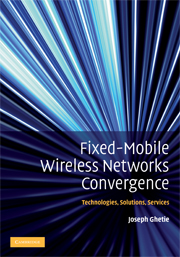Book contents
- Frontmatter
- Contents
- Disclaimer
- How the Book is Organized
- List of Figures
- List of Tables
- Preface
- Acknowledgments
- Acronyms
- Part I Wireless Communications: Networking and Management
- Part II Cellular Mobile Radio Networking and Management
- Part III Fixed Wireless Technologies: Networking and Management
- 6 Wireless Local Area Networking
- 7 Wireless Personal Area Networking
- 8 Wireless Metropolitan Area Networking
- 9 Wireless Near-Field Sensor Networking
- Part IV Fixed Wireless Cellular Mobile Networks Convergence and Integration
- Part V Fixed Wireless Cellular Mobile Networks Convergence: Standardized Networking Solutions
- Part VI Fixed-Mobile Convergence Services, Industry Trends, and Implementation Issues
- References
- Index
9 - Wireless Near-Field Sensor Networking
from Part III - Fixed Wireless Technologies: Networking and Management
Published online by Cambridge University Press: 21 August 2009
- Frontmatter
- Contents
- Disclaimer
- How the Book is Organized
- List of Figures
- List of Tables
- Preface
- Acknowledgments
- Acronyms
- Part I Wireless Communications: Networking and Management
- Part II Cellular Mobile Radio Networking and Management
- Part III Fixed Wireless Technologies: Networking and Management
- 6 Wireless Local Area Networking
- 7 Wireless Personal Area Networking
- 8 Wireless Metropolitan Area Networking
- 9 Wireless Near-Field Sensor Networking
- Part IV Fixed Wireless Cellular Mobile Networks Convergence and Integration
- Part V Fixed Wireless Cellular Mobile Networks Convergence: Standardized Networking Solutions
- Part VI Fixed-Mobile Convergence Services, Industry Trends, and Implementation Issues
- References
- Index
Summary
Near-Field Sensor Technologies
Near-Field Sensors (NFS)-based Networking (NFSN) is a generic term for wireless transmission technologies and networks confined to a short proximity between transmitters and receivers, generally a few centimeters, exceptionally 1–3 meters. Conceptually, NFC/NFSN covers digital data communications and multimedia information exchange and can be implemented using a variety of wireless technologies such as Radio Frequency Identification (RFID), Near-Field Communications (NFC), and Ultra Wide Band (UWB).
NFSN solutions, regardless of the technology that is adopted, must satisfy service requirements such as broadband transmission capability, reliability, scalability, simplicity, security, quality of services, manageability, and cost effectiveness. Special applications extend NFSN into movements of physical goods and persons, and even commercial and industrial operations. The array of applications ranges from individual customers/subscribers automatic identification to tracking commercial and industrial operations and chain of supplies of medium and large size businesses, all aimed at enhancing overall productivity. This presents challenges to designers of sensors and receivers, NFSN developers and integrators.
Although NFSN and its representative technologies, RFID, NFC, and UWB, are far from being wide-spread mass applications, the signs of their presence are visible in applications involving major retail organizations in their tracking of major items using RFID technologies, in physical persons that accept RFID tag implants to follow-up on health status information, and in spectrum allocation for UWB technologies across major markets.
- Type
- Chapter
- Information
- Fixed-Mobile Wireless Networks ConvergenceTechnologies, Solutions, Services, pp. 191 - 206Publisher: Cambridge University PressPrint publication year: 2008



